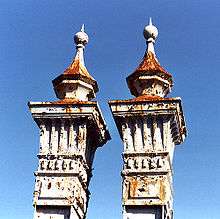Bridgeport Bridge (Ohio River)
| Bridgeport Bridge | |
|---|---|
|
| |
| Carries |
|
| Crosses | Ohio River |
| Locale | Wheeling Island, West Virginia |
| Other name(s) | Wheeling and Belmont Bridge |
| Heritage status | Historic American Engineering Record |
| Preceded by | Wooden covered bridge |
| Followed by | Military Order of the Purple Heart Bridge |
| Characteristics | |
| Material | Steel and wood |
| History | |
| Construction end | 1893 |
| Closed | 1998 |

The Bridgeport Bridge also known as the Wheeling and Belmont bridge (per the dedication plaque affixed to the structure) was a bridge which once carried U.S. Route 40 (US 40) over the back channel of the Ohio River between Wheeling Island, West Virginia, and Bridgeport, Ohio.
The steel-framed bridge, with a wooden deck, was built in 1893 to replace a prior wooden covered bridge that was built on the same site circa 1836. In fact, the 1893 bridge utilized the same piers that were built for the earlier bridge. The primary reason for construction of the new bridge was to accommodate the new electric street cars that were being deployed in Wheeling. With the construction of the Steel Bridge across the main channel of the Ohio River from Wheeling Island to the City of Wheeling circa 1889 electric steetcar service was expanded into Ohio, eventually stretching all the way west to the small mining town of Barton, which is approximately 15 miles (24 km) west of Wheeling. The bridge's traffic moved to an alternative bridge in 1998 and the bridge was demolished in 2011.
The bridge was documented by the Historic American Engineering Record program, which provided the following description of its significance in approximately 1987:
Built in 1893, the Bridgeport Bridge represented one type of bridges which could be ordered from catalogues at the end of the nineteenth century. Except for the replacement of the partially wooden roadway surface with steel grating in 1950, the bridge remained basically unchanged. Because the floor beams had become structurally unsound, a new, self-supporting, load-bearing deck structure was installed inside the trusses of the Bridgeport Bridge in 1987. Designed as a temporary means of carrying traffic until a new vehicular bridge is built, the deck installed was prefabricated in England and is a modern-day successor to the Bailey bridge type.[1]
In 1987 or so, there were plans for the building of a replacement vehicular bridge nearby, upstream. It was expected that the Bridgeport bridge would remain as a pedestrian and bicycle bridge.[1]
The wooden bridge deck was replaced in 1950 with steel grating, and the streetcar tracks were removed, as interurban rail service was discontinued in 1948. By 1987, the floor beams had become structurally unsound for automobile traffic due to extensive corrosion. A self-supporting, load-bearing deck structure, known as a Bailey Truss, was installed inside the trusses of the Bridgeport Bridge. This was only a temporary measure, as the bridge was replaced in 1998 with the adjacent Military Order of the Purple Heart Bridge. Sometime in 2009 much of the temporary Bailey Truss was removed. It is unclear if the steel grate floor had been removed prior to the installation of the Bailey Truss, but after the removal of its floor structure the Bridgeport Bridge was without a floor.
In 2009, it was announced that the bridge would be demolished, and the cost of demolishing the bridge was estimated to be less than $200,000.[2]
Early in the summer of 2011, WTOV-TV in Steubenville reported that the bridge was to be demolished, with demolition tentatively scheduled to start at the end of July 2011.[3] They reported that the West Virginia Division of Highways received a request from the U.S. Coast Guard to bring the bridge down as it was a safety hazard and pieces had fallen into the river. It also verified that many of the unique features of the bridge, such as the railings, signage, the finials on top, and plaques would be removed prior to demolition. The bridge demolition was expected to take 60 days and cost $750,000.00, which was considerably less than a $1.2 million estimate for demolition costs that had been given in 2000.
Explosive demolition of the bridge occurred on Monday, September 12, 2011.[4] Explosive charges were used to drop the bridge into the river, after which cranes began retrieving the steel parts for scrapping. Complete removal of bridge and piers was scheduled to be completed by October 31, 2011.
See also
- List of bridges documented by the Historic American Engineering Record in West Virginia
- List of crossings of the Ohio River
Sources
- 1 2 "Bridgeport Bridge, Spanning West Channel of Ohio River, U.S. Route 40, Wheeling, Ohio County, WV". Library of Congress.
- ↑ "Historic Wheeling Island bridge to be razed". Columbus Dispatch. Columbus, Ohio. August 31, 2009. Retrieved January 2015. Check date values in:
|access-date=(help) - ↑ https://web.archive.org/web/20110522165902/http://www.wtov9.com/news/27969493/detail.html. Archived from the original on May 22, 2011. Retrieved January 6, 2015. Missing or empty
|title=(help) - ↑ Betty J. Pokas (September 12, 2011). "Long-Standing Bridgeport Bridge Razed Today". Wheeling News-Register. Retrieved September 14, 2011.
External links
| Wikimedia Commons has media related to Bridgeport Bridge (Ohio River). |
- Bridgeport Bridge at Bridges & Tunnels
- Historic American Engineering Record (HAER) No. WV-25, "Bridgeport Bridge, Spanning West Channel of Ohio River, U.S. Route 40, Wheeling, Ohio County, WV", 28 photos, 3 measured drawings, 2 data pages, 6 photo caption pages
Coordinates: 40°04′21″N 80°44′19″W / 40.07250°N 80.73861°W